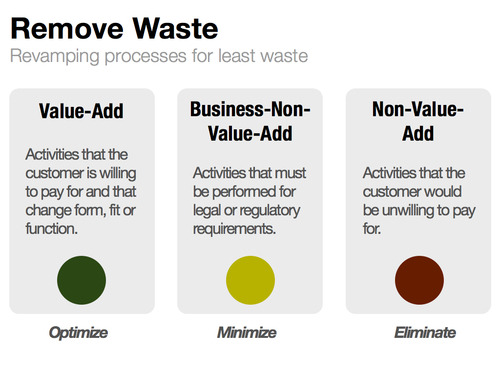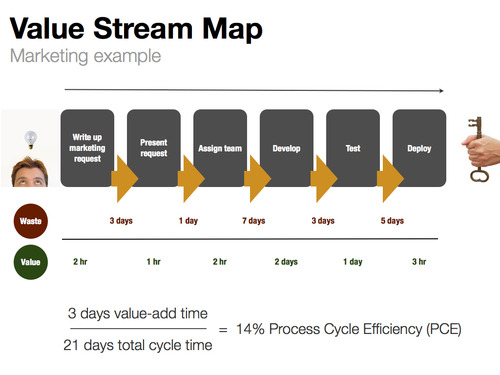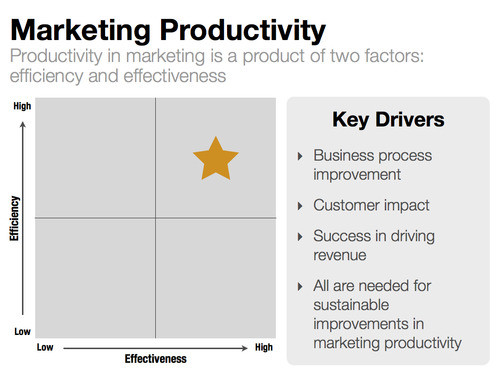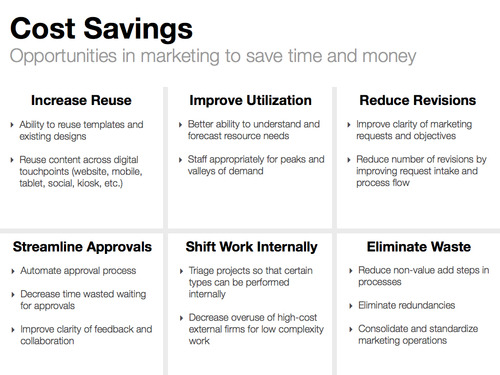In order to drive revenue growth, many companies have increased the introduction of new products. This, combined with a growing number of marketing channels, has placed additional demands on marketing organizations. In response, many CMOs at leading firms are overhauling marketing operations to improve agility, decrease cycle times, and increase throughput and efficiency. They are significantly increasing marketing productivity.
One of the tools that helps them drive these improvements is Lean thinking. Lean originated in manufacturing with the Toyota Production System and can be defined as a strategy for continuously improving the delivery of value to customers.
Lean seeks to remove waste and inefficiency from processes.
- Any process (or part of a process) that does not add value should be eliminated
- “Value” is that which customers are willing to pay for
- In that sense, Lean works from the outside of the company in

By thinking about activities in terms of waste, Lean thinking helps marketers examine their activities and processes in new ways. Any activities that are non-value-add should be minimized or eliminated. One of the tools in Lean to help with this is called a Value Stream Map.
In the example Value Stream Map below, a marketing request goes through a typical process for approval, development and deployment. The time for each activity is listed. The waste activity in this case is time spent waiting for approvals, waiting for resources to be assigned, and waiting as the request is handed off between different teams. The value-add activities are the activities where the actual work is being performed. The ratio of value-add time to total cycle time is called the process cycle efficiency (PCE) ratio. In this example, the PCE is 14%. Most operating processes have a PCE of 10% or less. World class performance is considered to be 50% PCE and higher. Most marketing processes have plenty of room for improvement.

A value stream map is a helpful tool when improving marketing productivity, which is a product of both efficiency and effectiveness. Key drivers are: business process improvement, customer impact, and success in driving revenue.

Efficiency Examples
Increase re-use of existing content
- Ability to reuse templates and existing designs
- Reuse content across digital touchpoints (website, mobile, tablet, social, kiosk, etc.)
Improve utilization
- Better ability to understand and forecast resource needs
- Staff appropriately for peaks and valleys of demand
Reduce the number of revisions
- Improve clarity of marketing requests and objectives
- Reduce number of revisions by improving request intake and process flow
Decrease review cycle resources and people costs by automating workflows
- Automate approval process
- Decrease time wasted waiting for approvals
- Improve clarity of feedback and collaboration
Right size the use of partners/ suppliers
- Triage projects so that certain types can be performed internally
- Decrease overuse of high-cost external firms for low complexity work
Accelerate time to market by leaning processes and removing waste
- Reduce non-value add steps in processes
- Eliminate redundancies
- Consolidate and standardize marketing operations

Effectiveness Examples
Improve measurement
- Ability to understand true return on marketing investment (ROMI)
- Insight into which marketing tactics are most effective
- Increased ability to optimize marketing mix and predict revenue
Ensure consistency
- Ability to reuse consistent digital marketing assets
- Opportunity to apply brand templates
Drive faster cycle time
- Increased speed to market
- Ability to produce context-sensitive marketing
Ensure alignment between marketing and sales
- Transition leads from the marketing funnel to sales at the right point in time
- Ensure alignment of messaging and tactics
Results
Companies that have begun to optimize marketing operations have reported *:
- Decreased campaign cycle time by 32 percent
- Reduced print production costs by 30 percent
- Reduced time spent on project management by 71 percent
- Reduced rework by 35 percent
- Approved projects 27 percent faster
- Reduced time to market for new products by 25 percent
The push to increase marketing productivity is here, and Lean thinking is helping many marketing organizations rise to the challenge. Has your organization begun to optimize marketing? Has efficiency improved? Has effectiveness increased? What approaches are yielding the greatest benefits?
.
* Jain, N. and Seiler, M. (2002) The Case for Marketing Resource Management. Excerpt from Freeland, J. The Ultimate CRM Handbook: Strategies and Concepts for Building Enduring Customer Loyalty and Profitability.



